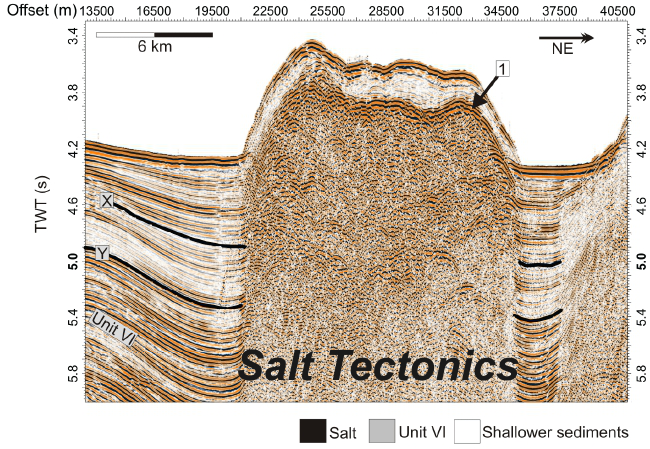Salt Tectonics
Salt provinces originate from shallow marine settings, where high evaporation leads to brine formation and settling of salt crystals. Over geologic time periods thick salt units can develop, as it occured during the Zechstein in the North German Basin or in the late rifting phase in Gondwana before the formation of the South Atlantic, or in the Gulf of Mexico.
Our research on the SW African margin started with the pre-site survey for ODP Leg 175, when we discovered pockmarks in the Congo Fan. Subsequently, Meteor Cruise M47/3, M56 and M76/3b carried out further research in the salt province, which is one of the driving forces for shallow gas migration from depth, gas hydrate formation and fluid/gas seepage.
Since the breakup of the South Atlantic occured asymmetrically, the salt basin was split at 13°S, and the upper plate with the salt, which accumulated during the rifting phase, remained at Africa to the North and at South America to the South. Offshore Brazil, salt-related features were investigated during Meteor Cruise M49/3.
Studies in the Southern Gulf of Mexico were initiated by the interest of asphalt volcanism, which is likely the results of deep sediment burial in conjunction with salt diapirism.
Both the Congo margin and the Southern Gulf of Mexico are characterized by rafting of margin sediments, gliding on the salt layer downslope and leading to quite irregular patterns of accumulation due to local subsidence.
In the North Sea, salt activity is much less pronounced, but subtle effects of diapirism and sediment deformation can still be seen in high-resolution seismic data.
The North German Basin reaches far into the Baltic Sea, where salt domes have also been imaged by seismic surveys.
Publications Congo / Angola
Wenau, Stefan, Spiess V. (2018) Active Seafloor Seepage Along Hydraulic Fractures Connected to Lateral Stress From Salt-Related Rafting: Regab Pockmark, Congo Fan. Journal of Geophysical Research: Solid Earth 123 (5), 3301-3319, https://doi.org/10.1002/2017JB015006.
Wenau, Stefan, Spiess V., Pape T., Fekete N. (2017) Controlling mechanisms of giant deep water pockmarks in the Lower Congo Basin. Marine and Petroleum Geology 83, 140-157, https://doi.org/10.1016/j.marpetgeo.2017.02.030.
Wenau Stefan, Spiess V., Pape T., Fekete N. (2015) Cold seeps at the salt front in the Lower Congo Basin I: Current methane accumulation and active seepage. Marine and Petroleum Geology. 67, 894-908, https://doi.org/10.1016/j.marpetgeo.2014.07.032.
Wenau, Stefan (2013) Seismic and acoustic imaging of fluid seepage structures in different sedimentological and tectonic settings in the Lower Congo Basin. Dissertation, xx. pp.. https://media.suub.uni-bremen.de/bitstream/elib/550/1/00103442-1.pdf.
Sahling, Heiko, Bohrmann G., Spiess V., Bialas J., Breitzke M., Ivanov M., Kasten S., Krastel S., Schneider RR. (2008) Pockmarks in the Northern Congo Fan area, SW Africa: Complex seafloor features shaped by fluid flow. Marine Geology, 249, 206-225, https://doi.org/10.1016/j.margeo.2007.11.010.
Publications Gulf of Mexico
Ding, Feng, Spiess V., MacDonald IR., Brüning M., Fekete N., Bohrmann G. (2010) Shallow Sediment Deformation Styles in North-Western Campeche Knolls, Gulf of Mexico, and their Controls on the Occurrence of Hydrocarbon Seepage. Marine and Petroleum Geology, 27, 959-972, https://doi.org/10.1016/j.marpetgeo.2010.01.014.
Brüning Markus, Sahling H., MacDonald IR., Ding F., Bohrmann, G. (2010) Origin, distribution, and alteration of asphalts at Chapopote Knoll, Southern Gulf of Mexico. Marine and Petroleum Geology, 27, 1093–1106, https://doi.org/10.1016/j.marpetgeo.2009.09.005.
Ding, Feng (2009) Near-surface Sediment Structures at Cold Seeps and their Physical Control on Seepage: A Geophysical and Geological Study in the Southern Gulf of Mexico and at the frontal Makran Accretionary Prism/Pakistan. Dissertation, xx pp.. https://media.suub.uni-bremen.de/bitstream/elib/2620/1/00011331.pdf.
Ding, Feng, Spiess V., Brüning M. , Fekete N., Keil H., Bohrmann G. (2008) A conceptual model for hydrocarbon accumulation and seepage processes around Chapopote asphalt site, southern Gulf of Mexico: From high resolution seismic point of view, J. Geophys. Res., 113, B08404, https://doi.org/10.1029/2007JB005484.
Publications North Sea / Baltic Sea
Wenau, Stefan, Alves T. (2020) Salt-induced crestal faults control the formation of Quaternary tunnel valleys in the southern North Sea. Boreas. http://dx.doi.org/10.1111/bor.12461.
Publications Brazil
n/a
Master Theses
Sierra, Gabriella (2020) Impact of Salt Tectonics and Glaciations on Sedimentation in the North Sea
Iliev, Milen (2014) Description, Localization and Dating of Depositional, Fluid-transport and Tectonic processes in the Northern Congo Basin using Multichannel Seismics
Caparachin, Cesar (2014) Subsidencia de Mini Cuencas Poligonales
Media
 1
1
